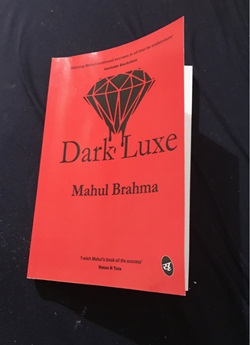Dr Mahul Brahmais a luxury commentator and columnist. He is also an award-winning communicator, heading CSR, corporate communications and branding for Tata group company mjunction. He has been a senior journalist for a decade with The Economic Times, CNBC TV18, Reuters, and the Indian partner of The New York Times. He is alumni of St Xavier’s College, Cambridge Judge Business School and MICA. His debut micro short film, Post-It as a filmmaker has received accolades from national and international film festivals. He is an avid golfer.
In this interview with Swetha Amit, Brahma talks about the dark side of luxury and what makes people crave material posessions.

Mahul Brahma
Dark Luxe is an interesting collection of stories that explore the dark side of luxury. What led you to write this book?
It was during my stint with the India partner of New York Times where I was editing a luxury supplement, I interviewed many brand custodians and members of the royal family to understand the concept of luxury. Off the record, they had also shared horror stories that either formed royal or corporate folklore. These are tales of gore and blood, hiding behind the dazzle.
So these tales and my responsibility as a luxury commentator to give a holistic picture of luxury to my readers inspired me to write this book. So, Luxe Dulogy together aims at showcasing both the dazzle and the darkness. While with my first book Decoding Luxe I traced the evolution and history of luxe or dazzle in India, with Dark Luxe I exposed the darkness that safely hides behind the dazzle. From the glossy magazine pages with “price on request” tag, Dark Luxe takes readers to the other end of the spectrum.
Your earlier book Decoding Luxe was a work of non-fiction while Dark Luxe is fiction. How challenging was it to shift from non-fiction to fiction?
Decoding Luxe is more of a book on history, evolution and strategy, based on facts and data. I have been a senior journalist for a decade, so writing non-fiction comes very naturally to me. It was quite difficult making this transition.
The objective of the book of exposing the darkness of luxury to everyone demanded that I take help of my imaginative faculty so that I have the freedom of expression. However, you will see these stories are also interspersed with facts and data.
These 13 short stories explore the dark side of luxury and human nature. Were these stories inspired from any real-life instances or characters?
These horror stories are pure work of fiction. They sure were inspired by real life incidents, but not limited by it. These stories are buried deep into the subterranean or in the sanctum-sanctorum of our hearts. Dark Luxe tells you the tale of how we humans are all the same in our core, dominated by one or many of the seven deadly sins.
Your book showcases that luxury does not necessarily bring in happiness. What do you think makes people crave material possessions?
There can be multiple reasons for the craving of material possessions, but I believe greed tops the list. Another dominating reason is ‘one-upmanship’ wherein it becomes a competition, a game of pulling the other person down with material possessions. In today’s time it is not hard to find wherein the exorbitant expenditure on the marriage has become a parameter of your societal hierarchy. Long back, during the days of the zamindars in Calcutta, I know of a case where two such zamindars competed with each other on the number of horses that drive their pheatons (horse carriages). So, everyday one horse gets t be added to the carriage. They stopped the fight only when one decided to replace the horses with zebras.
Another very prominent reason is to get a sense of exclusivity that these luxury brands promise. Typically most luxury brands use this lever very effectively. When Rolex tells you legends like JFK and Martin Luther King Jr used to wear your watch, it sure will give you a sense of exclusivity. These are very subtle tricks that mind plays wherein we all crave to be associated with legends.
You have mentioned how you were taught to be neutral as a journalist. Did this quality help you look at luxury in a more rational manner and perhaps help you in penning down this book?
My journalism training of being unbiased and neutral, of having a commitment to readers of showing both the sides of a story, did help me a lot in writing this book as well as the earlier one. It gave me unique perspective as a luxury commentator, who is neither swayed by the millions of dollars nor by the gory tales, but feels a deep commitment to share them with his readers.
I wanted more and more people to look at luxury the way I do and appreciate it as a subject, look beyond price tags at craftsmanship and excellence. I also wanted my readers to understand the darkness that lies deep within us humans and how luxury plays its part in that drama.
In the quest of luxury, one needs to compromise on their identity at times, as its seen in the story of Life of an Empress. How does one retain their identity in a world of material pleasures?
The lure of luxe is very hard to ignore and so almost everyone is consumed by its sway. Then luxury becomes an integral part of your identity. So, which brands your wear, where you live, which car you drive, and the likes, tend to define who you are. Your astronomical spends becomes directly proportional to your societal strata. It is the way the society is so it will be wrong to put the entire blame on the individual.
Retaining ones identity is becoming more and more difficult with every passing day but still there is hope. Humanity, intellect and creativity more strongly defines one’s identity. So it is always a matter of priority at an individual level.
An interesting aspect in your book is how you have written the 13 stories from the perspective of the luxury objects whether it’s the luxury yacht or a Tiffany’s ring. What made you choose this particular narrative style?
The luxury products in these stories are the protagonists and they share their version of the event in which they have been made an accessory or in some cases they have acted on their own accord. So selection of products boiled down to the choice of protagonists, and here it was a mix of imagination and reality. In some cases the stories led to the protagonist, in others the protagonists led to the stories. Whether it is the Princess Cut Tiffany ring or the Rolls Royce Phantom or the Rolex watch or the luxury yacht or a Dom Perignon vintage champagne – all of them share their tales as a silent witness that are far from the dazzle they exude.
What according to you constitutes luxury?
Luxury has its origin in a word “luxe”, which means dazzle. So anything that dazzles you is luxury. And thus, the same way what dazzles you may not dazzle me, so luxury is relative. For example, I may be happy just aspiring for a Harley Davidson while a certain Nizam may purchase 30 of these bikes for his postmen. It is all about relativity.
Penning such books can be a life-altering experience. Has it changed you in any way?
It has indeed been a life-altering experience. It was very difficult to put myself in the shoes of these luxury goods and to live their horror story and then pen them with all sincerity. This experience has given me a new and holistic perspective of luxury. Living the horrors with the protagonists have been a roller coaster ride for me. I have developed every character very meticulously just as humans, detailing their emotions, response, behavior and thought process to every situation so that the readers can relate to them.
Lastly what are your future plans? Any more books in the pipeline?
After the launch of Dark Luxe, I had taken a break. I have just started working on my next book, which is still in a formative stage. It will be a novel and luxury will be an integral part of it.
May your quest for luxe continue.



















